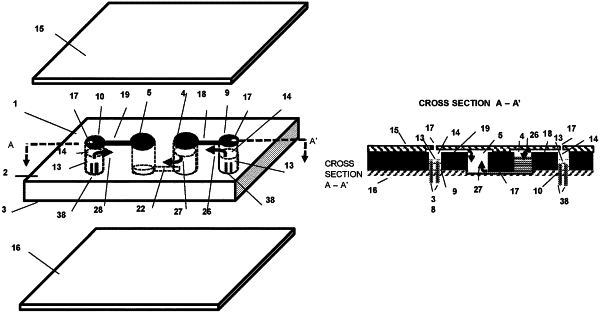| CPC B01L 3/502746 (2013.01) [B01L 3/50273 (2013.01); G01N 35/00069 (2013.01); B01L 2200/16 (2013.01); B01L 2300/0645 (2013.01); B01L 2300/0819 (2013.01); B01L 2400/0415 (2013.01); B01L 2400/0463 (2013.01); B01L 2400/0487 (2013.01); B01L 2400/082 (2013.01)] | 32 Claims |

|
17. A method for actively controlling flow resistance in microfluidic channels of a microfluidic system, comprising:
a) providing a microfluidic system comprising a microfluidic device, wherein the microfluidic device comprises:
i) a housing, wherein the housing comprises a top end and a bottom end;
ii) a plurality of reagent chambers and a plurality of pressure-generating chambers, wherein the reagent chambers and the pressure-generating chambers are positioned in the housing, and wherein:
aa) the pressure-generating chambers produce a pressure-generating fluid using no mechanical moving parts;
bb) the reagent chambers are connected by at least one gas channel at the top end of the housing to at least one of the pressure-generating chambers; and
cc) the reagent chambers are connected by one or more liquid channels at the bottom end of the housing to one or more of the pressure-generating chambers;
iii) a top substrate enclosing the pressure-generating fluid chambers, wherein the top substrate comprises fluidic channels connecting the pressure-generating chambers to one or more vent holes, thereby enabling movement of one or more reagent fluids in the one or more liquid channels at the bottom end of the housing; and
iv) a bottom substrate enclosing the reagent chambers;
wherein the microfluidic system is configured to achieve passive flow resistance during filling of the microfluidic device with the pressure-generating fluid to prevent mixing of the pressure-generating fluid with the reagents when the microfluidic system is not in operation; and
b) activating the one or more pressure-generating chambers to pump the pressure-generating fluid toward the one or more reagent chambers and controlling and balancing pressure of the pressure-generating fluid to achieve active flow resistance resulting in the movement of the one or more reagent fluids in a desired direction, wherein the movement of the one or more reagent fluids is enabled.
|